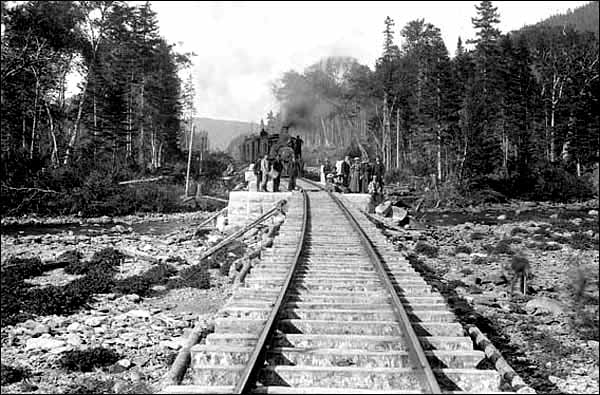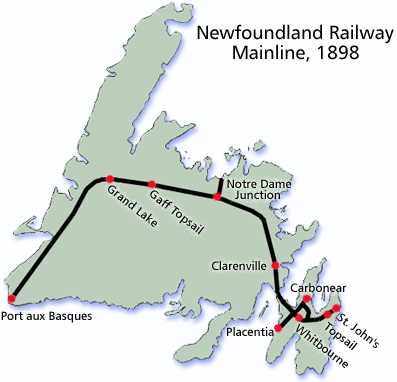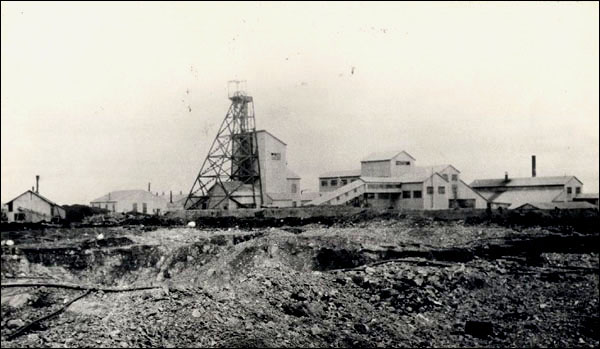Transportation and Land-Based Industries
Advances in transportation during the late 19th and early 20th centuries dramatically affected the development of the forestry and mining industries in Newfoundland and Labrador. Construction of the railway and new roads opened up the island's interior, making it possible for government and business officials to exploit the region's previously undeveloped natural resources.

During the first few decades of the 1900s, numerous new mills, logging operations, and mines appeared along the railway. As industry officials discovered more mineral and forest resources in the island's interior, they often built new roads or spur tracks linking their operations to the main railway or to more populated centres. As a result, the development of land-based industries not only occurred because of new modes of transportation, but also aided in their proliferation.
Railways and the Forest Industry
The late 1800s were a difficult time for Newfoundland and Labrador's traditional economy. Falling prices and decades of over-exploitation forced both the cod and seal fisheries into decline, yet few employment opportunities existed outside these troubled sectors. Government officials recognized the economy could no longer support a growing population and hoped to create jobs by exploiting other natural resources.
Geological surveys in the first half of the 1800s indicated the island's interior might be rich in undeveloped mineral and forest resources. The government hoped the construction of a railway would allow easier access to this region and contracted Robert Gillespie Reid to build and operate the railway in 1890. By the time it was completed eight years later, the main track ran northerly from the Avalon Peninsula to the Exploits Valley before turning south and ending at Port aux Basques.

The sawmilling industry was the first to benefit from the new mode of transportation. As tracks progressed westward throughout the 1890s, sawmills appeared at Terra Nova (1893), Benton (1894), Glenwood (mid-1890s), Norris Arm (late 1890s), and elsewhere. Although this industry fell into decline in the early 1900s because of a white pine shortage, a growing pulp and paper industry began to exploit forest lands surrounding the railway. Mills opened at such places as Black River, Placentia Bay (1897), Grand Falls (1909), Bishop's Falls (1911), Campbellton (1914), and Corner Brook (1925).
Some companies acquired timber lands through a railway contract Reid had negotiated with the government. In 1893, Reid agreed to operate the railway for 10 years in return for surface and mineral rights to 5,000 acres of land for each mile he operated. This gave Reid almost 6,500 square miles of property along the railway. In 1905, he sold some of this land to the Anglo-Newfoundland Development (AND) Company to establish a mill at Grand Falls; Reid also supplied Albert E. Reed and Company with land for a pulp and paper mill at Bishop's Falls.
Many mill operators built branch lines connecting their property with either the main railway or with other parts of the island. This was the case with the AND Company, which built a 35-kilometre track linking its Grand Falls mill with the port town of Botwood. From there, the company shipped newsprint to foreign markets. Bowater's also operated a private railway for its Corner Brook mill yard and built a 32-kilometre logging railroad from Deer Lake to Adie's Pond.
Railway construction was not without problems for the forestry sector. The sparks and improperly disposed hot cinders of locomotives, along with those belched from improperly maintained boilers that powered steam saw mills, regularly caused disastrous wild fires. Anxious to foster economic diversification, the Newfoundland government preferred to attribute most wild fires to supposedly careless fishing people, rather than blaming the saw-mill boilers and locomotives, as was warranted by the government's own investigations of particularly disastrous forest fires in 1903 and 1904. Industrial sources of wild fires became a major threat to forest resources throughout the first half of the 20th century.
Transportation and Mines
As with paper mills, proximity to the railway and other modes of transportation helped determine how successful a mining operation could become. If developers could not access mineral deposits or ship them to the marketplace, then the operation would fail. Although geologist Joseph Jukes reported evidence of coal and other mineral resources after surveying the island in the 1830s and 1840s, accessibility was often a problem.
The need for better modes of transportation became even more apparent to government and mining officials after a string of copper mines opened in Notre Dame Bay on the island's northeast coast in the late 1800s. Because no roads linked the mines to St. John's – the country's centre of commerce and industry – operators could only ship ore out of the bay by boat. However, the mines could not export anything during the ice-bound months of November to March. This placed them at a tremendous disadvantage to other mines in warmer climates, which could reach the marketplace all year.
Wishing to overcome this obstacle, the Whiteway government planned to build a railway from St. John's to Notre Dame Bay. Unfortunately, the copper boom had largely ended by the time construction began and planners decided to bypass the bay altogether.
Nonetheless, the railway did open up Newfoundland's interior to prospectors, making it possible for mining to begin at Buchans in 1927. Unlike most mines on the island, which were close to the coast, the Buchans zinc, lead, and copper mine was in central Newfoundland and therefore isolated from bays and other communities.
In 1926, the AND Company and the American Smelting and Refining Company (ASARCO) entered into a formal partnership to exploit the mineral deposits at Buchans. At that time, the site was an undeveloped wilderness; by the end of 1927, Buchans boasted a mine, a church, a school, and living quarters for workers and their families. ASARCO also built a 35-kilometre railroad to Millertown, where it linked up with the main line. Workers used this track to ship Buchans ore to the port of Botwood for export elsewhere.

The railroad made it possible for a handful of other, though less well-known, mines and quarries to operate in central Newfoundland. These included granite quarries at Benton (near Gander) and the Gaff Topsails (near Buchans), as well as a coal mine at Howley, near Grand Lake. None of these, however, were as successful as the Buchans mine, which remained active for close to 60 years before closing in 1984.




